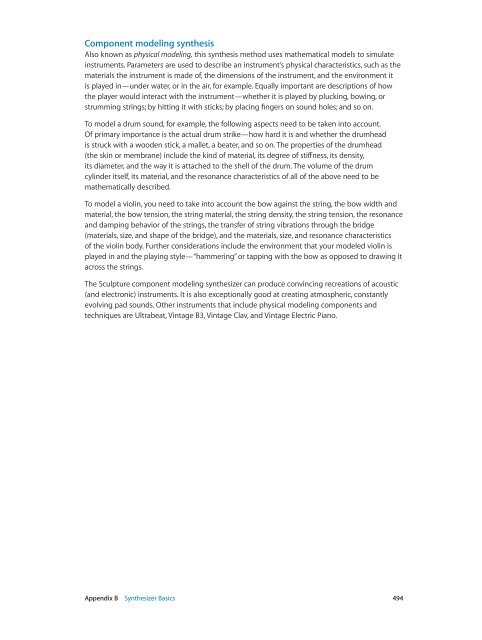Apple MainStage 3 Instruments - MainStage 3 Instruments
Apple MainStage 3 Instruments - MainStage 3 Instruments
Apple MainStage 3 Instruments - MainStage 3 Instruments
Create successful ePaper yourself
Turn your PDF publications into a flip-book with our unique Google optimized e-Paper software.
Component modeling synthesis<br />
Also known as physical modeling, this synthesis method uses mathematical models to simulate<br />
instruments. Parameters are used to describe an instrument’s physical characteristics, such as the<br />
materials the instrument is made of, the dimensions of the instrument, and the environment it<br />
is played in—under water, or in the air, for example. Equally important are descriptions of how<br />
the player would interact with the instrument—whether it is played by plucking, bowing, or<br />
strumming strings; by hitting it with sticks; by placing fingers on sound holes; and so on.<br />
To model a drum sound, for example, the following aspects need to be taken into account.<br />
Of primary importance is the actual drum strike—how hard it is and whether the drumhead<br />
is struck with a wooden stick, a mallet, a beater, and so on. The properties of the drumhead<br />
(the skin or membrane) include the kind of material, its degree of stiffness, its density,<br />
its diameter, and the way it is attached to the shell of the drum. The volume of the drum<br />
cylinder itself, its material, and the resonance characteristics of all of the above need to be<br />
mathematically described.<br />
To model a violin, you need to take into account the bow against the string, the bow width and<br />
material, the bow tension, the string material, the string density, the string tension, the resonance<br />
and damping behavior of the strings, the transfer of string vibrations through the bridge<br />
(materials, size, and shape of the bridge), and the materials, size, and resonance characteristics<br />
of the violin body. Further considerations include the environment that your modeled violin is<br />
played in and the playing style—“hammering” or tapping with the bow as opposed to drawing it<br />
across the strings.<br />
The Sculpture component modeling synthesizer can produce convincing recreations of acoustic<br />
(and electronic) instruments. It is also exceptionally good at creating atmospheric, constantly<br />
evolving pad sounds. Other instruments that include physical modeling components and<br />
techniques are Ultrabeat, Vintage B3, Vintage Clav, and Vintage Electric Piano.<br />
Appendix B Synthesizer Basics 494
















